In this age of Steam shovelware and low-effort mobile ports it’s difficult to remember a time when we weren’t awash in terrible adaptations of various Games Workshop properties. These days you can’t throw a rock without hitting a digital version of one of their Specialist Games from the ‘90s – Space Hulk, Mordheim, Adeptus Titanicus, Man O’ War, Battlefleet Gothic and so on — and with the notable exception of Battlefleet Gothic all of them have ranged in quality from “sub-par” to “indescribably awful”. Years before the floodgates opened, however, there was Cyanide’s 2009 adaptation of the classic American-Football-but-with-Orcs punch ‘em up Blood Bowl, which was a game that got a headstart on everyone else through a surprising application of copyright infringement1. Unlike the many games that followed it Blood Bowl didn’t piss about trying to figure out how to convert the board game into something more appropriate for a videogame, and instead just ported the board game rules across on a 1:1 basis. This proved to be an unusually successful approach, for two very good reasons that I’m surprised the later GW adaptations (including some of Cyanide’s own) didn’t pick up on. One is that while it was far from perfect Cyanide had managed to balance automating away most of the cruft that slows down a physical game of Blood Bowl while still preserving the board game feeling with stuff like highly visible digital dice rolls. The other is that people liked the old Specialist Games for a reason, and Blood Bowl is the best of the lot. You don’t need to go tinkering with the gameplay to make it work. It already does.
As long as you have somebody else to play it with, anyway.
I have a lot of time for the Cyanide Blood Bowl despite there being an awful lot wrong with it – the baffling real-time mode, the limited league options and the ridiculous network errors being just the stuff I can remember off the top of my head eleven years later. Its biggest problem, though, was that its AI was basically non-functional and couldn’t even put up slight resistance to a moderately skilled human player. Blood Bowl is always going to be at its best when played against another human being, of course, and for a time the Cyanide Blood Bowl had a few bustling online leagues going based out of places like the RPS forum community, and so this wasn’t quite the kneecapper it probably should have been. There’s a reason I keep referring to it as “the Cyanide Blood Bowl”, though, and that’s because when it comes to the business of playing other people using a 1:1 adaption of the Blood Bowl rules it’s actually got some competition in the form of the far older FUMBLL client. FUMBLL is much more basic than Cyanide’s effort in terms of UI and graphics (although the pixel art used for the players is not unattractive) but it has been around for nearly twenty years and is fully feature complete, including every single team available in the board game. And most importantly, FUMBLL is free. So when judged on a metric of “playing Blood Bowl against your friends on a computer machine”, the Cyanide Blood Bowl needs to offer something over and above just adapting the ruleset to justify why I’d pay some money for that instead of going with the free equivalent. Their first Blood Bowl game didn’t really manage it, but this is a review of Blood Bowl 2, released in 2016 but which I picked up for cheap a few weeks back to play in a league with some friends. Have Cyanide learned from the first game’s shortcomings?
First, a not-so-quick rundown of Blood Bowl itself. The description “American football but with Orcs” is a quite literal one: you have a 13 by 24 square pitch divided into two halves, with two teams of eleven players facing off across the line of scrimmage along the centre of the pitch. Each drive starts with the defending team kicking the ball into the attacking team’s half, who then have to pick it up and get it over the touchline at their opponent’s end of the pitch in order to score a touchdown. There are a number of strategies available for them to do this, often dictated by the type of team they are — they can try a slow, block-heavy advance, tying up opposition team members to create space for their ball carrier to move forward, they can try fast, dodge-heavy plays where the ball is passed from player to player to player all the way to the end of the pitch, or they can risk positioning a single player at the touchline and then attempt to throw the ball to them. If they succeed the roles switch and it’s their turn to try and prevent the opposing team doing the same to them. The game is separated into two halves of eight turns each; once all sixteen turns have been played the game is over and the team with the most touchdowns wins.
And if that were all Blood Bowl was it’d be an unremarkable (if fairly competent) game. Fortunately this is where the “with Orcs” part comes in, as the range of Blood Bowl teams includes pretty much every single race in the Warhammer Fantasy universe, from Orcs to Elves to Undead to Chaos to Halflings to Lizardmen. Each team can field four or five different types of player; the baseline are the extremely average Humans, who get Throwers (self-explanatory), Catchers (also self-explanatory), Blitzers, who can use the single Blitz action each team gets per turn to charge at a player and knock them flat on their ass, and bog-standard Linemen who excel at nothing in particular and are mostly there to prevent the opposing team from getting through to your ball carrier. Even the Humans get to field a single Ogre player, though, who is decidedly not average; the Ogre is very strong (making him more likely to succeed on a block) and has the Mighty Blow skill, which makes a successful block from him more likely to break an opponent’s armour and cause an injury that removes them from the rest of the match — and because this is Blood Bowl this injury can be anything from a harmless Badly Hurt with no lasting effects to outright player death.
When it comes to the actual fantasy races in the game it turns out each of them has their own gimmick granted by their racial or factional attributes. Elves are kings of the passing game, able to easily score one- or two-turn touchdowns with an improbable combination of dodges, handoffs and throws, but their incredible speed and agility is compensated for by their armour being made of paper and they lose at least 2-3 players per game to injury. Lizardmen combine meaty Sauruses (who are great at blocking but can’t pick up the ball) with tiny, nimble Skinks who can take advantage of their small size to ignore enemy tackle zones but who are also very fragile and more likely to die if they get caught. Chaos teams are strong and have access to mutation abilities such as Claw which acts as a can-opener for otherwise heavily-armoured players, so their optimal strategy is to ignore the ball to start with and instead focus on causing as much carnage as possible so that the opposing team doesn’t have enough players left to stop them from scoring. There’s even ridiculous teams like the Goblins, who compensate for their small size with an array of secret weapons such as bombs, chainsaws and pogo sticks (for jumping over enemy defensive lines), and the Halflings, who drop like flies but who can field two Treemen that can throw a Halfling carrying the ball towards the enemy endzone. Broadly speaking each team sits somewhere on the spectrum between “bashy” and “dodgy”, but there is a lot of differentiation2 and no two teams are exactly the same. With 24 teams included in the Legendary Edition of Blood Bowl 2 this creates an almost endless set of potential matchups, and your strategy is going to change from game to game depending on who you’re playing and who you’re facing. For example, if you’re playing the Orcs you can usually boss the line of scrimmage with your Strength 4 Black Orc Blockers, but you might come up against a Khemri player who can field an equal number of Strength 5 Tomb Guardians, and in that scenario it might be a better idea to back off and not engage in a punching war until you’ve removed some of his more fragile skeleton players from the pitch (those bones break so easily) and can bring superior numbers to bear.
Once you’ve decided on a game plan you’ll need to get to grips with Blood Bowl’s fascinating spin on turn sequencing and risk management to actually implement it. When you take a turn in Blood Bowl you get to move all of the players on your team in the order that you decide. A player can throw a block (i.e. punch) instead of moving, and each turn gives you a single Blitz move where one player can move and block at the same time, but the rest of Blood Bowl’s actions are baked into the act of moving. Moving over a square with the ball in it will make that player automatically attempt to pick up the ball on their way through that square. Moving next to another player and clicking on them will hand off the ball, but they’ll have to make a successful Catch roll to do so. Opposing players generate a Tackle Zone in the eight squares immediately surrounding them, and moving through a Tackle Zone requires a successful Dodge roll – overlapping Tackle Zones from multiple opposing players increase the negative modifier on this roll, so it’s a good idea to avoid heavy concentrations of enemy players unless you’ve knocked them sprawling first with a block. Passing the ball requires a successful Pass roll from the player throwing it, a successful Catch roll from the player receiving it, and for any opposition players who might be standing in the path of the ball to fail their Intercept rolls.
All of the above action rolls are made by rolling a standard six-sided dice and attempting to beat a certain score dictated by the player’s Agility stat plus any positive or negative modifiers granted by player abilities or on-pitch effects such as Tackle Zones — this is one of the places where having a digital version of Blood Bowl helps a lot, as it crunches all of the modifiers for you and presents you with a simple number to beat allowing you to easily understand which actions are risky even if you don’t fully grasp the mechanics behind it. When you throw a block, though, you instead roll one or more special Block Dice. These are also six-sided but have special values on them — Opponent Down, Opponent Stumbles, Both Down, Attacker Down and Push — that indicate the result of the block. If both players have equal Strength values a single Block Dice is rolled and you have to live with the result. If one player is stronger than the other then two dice are rolled and the stronger player gets to pick the better of the two. This makes players with a high Strength value difficult to block against because the opposing player will get to pick which Block Dice to use (and they’ll always pick the one that’s worst for you) — that is, unless you stack up multiple players next to them who each grant your blocking player a +1 Strength bonus. Ganging up in this way can be very effective; I was playing some Lizardmen as Undead and attempting to kill their Skinks (Strength 2) with my Wight (a Blitzer, Strength 3) as this is the key to beating Lizardmen, but the tables quickly turned when two Skinks scampered up to him and a third Blitzed him. The two supporting Skinks gave the Blitzing Skink a +2 Strength bonus and 4 Strength in total, which let them roll two dice and pick the Opponent Down result, and the Wight promptly failed his armour roll, failed his injury roll and got a Dead result on the casualty roll. This goes to show that Strength is an important characteristic when blocking, but positioning is even more important as a poorly-positioned player can still be overwhelmed no matter how strong they are.
The big thing to take away from the last two paragraphs is that a typical turn of Blood Bowl involves rolling a hell of a lot of dice. Every single action that’s not moving from unmarked space A to unmarked space B through unmarked spaces C, D and E will require succeeding at at least one dice roll. And the big catch with all of these dice rolls is that while you will, ideally, get to move all of your players during your turn, the moment you fail any dice roll (either by failing to roll higher than the target value on a D6, or throwing a block that results in the blocking player being knocked over) your turn immediately ends. Your Orc tripped up on the second move of the turn and you still have nine players standing around twiddling their thumbs? Sucks to be them, they’re now not going to be able to move until your opponent either finishes his next turn or screws it up like you just did. A premature turnover can be absolutely catastrophic for your team, with players caught out of position and opposing players left unmarked and unblocked to do what they will. Above all else, succeeding at Blood Bowl requires you to minimise the chances of this happening, which means coming up with a sequence of moves that executes the play you want in an order starting from the most likely to succeed to the least, and mitigating the riskiest moves by prepositioning players in covering positions in case it all goes wrong. You also ideally want to be positioning your team so that your opponent is forced to make as many dice rolls as possible in order to execute the things that they want to do, as the more dice rolls they have to make the more chance there is of a failure and an early turnover in your favour. And because turns in Blood Bowl are on a timer, you have to figure all of this out in around 3 minutes3.
Now, if you’re anything like me the idea of your turn ending simply because of the capricious whims of the RNG probably sounds quite horrifying. However, where the potential for bad dice rolls give most actions in the game an element of risk, Blood Bowl gives you several additional tools for managing that risk which mostly take the form of being able to reroll failed dice rolls in specific scenarios. Players can have specialised skills above and beyond their statlines that either modify dice roll outcomes or allow rerolls of certain types of dice roll. For example, a player with an average Agility stat of 3 will be able to pick up a ball lying in an unmarked square on a roll of 3 or more on a D6. That might sound fairly reasonable, but it’s still a one in three chance of your turn ending if he rolls a 1 or a 2. If he had the Sure Hands skill, however, he’d be able to automatically reroll a single failed pickup roll per turn, meaning he’d have to roll a 1 or 2 on two dice at the same time to fail the roll outright and which reduces the chance of failure to one in nine. This makes him a great player for retrieving the ball, but Sure Hands does nothing to help him with making Dodge rolls or Pass rolls or Catch rolls – there are separate skills (handily called Dodge, Pass and Catch) that allow separate rerolls for each of those moves, and so by stacking a couple of these skills onto a player you can make them into specialists that are much more likely to succeed at their specific job on the team. Positional players (Catchers, Throwers and the like) start with skills that help them do the thing they’re named after, while standard Linemen don’t start with any skills, but can learn them as they gain experience. And if you do find yourself having to do something risky with a Lineman before they’ve levelled up you can at least fall back on the Team Reroll; you only get a few of these to use each half and you can only use one per turn, but they allow you to reroll any failed dice that hasn’t already been rerolled by a skill such as Dodge, which at least gives you a single moderate chance of success when using an unspecialised player to do something outside of their comfort zone.
The reroll skills and the Team Reroll are extremely powerful and probably the easiest to explain in terms of how they can dramatically improve your odds, but there are plenty of other, more baroque skills that more directly interact with Blood Bowl’s ruleset. Block, Dodge and Wrestle all change what happens when you throw a block. Grab, Sidestep, Fend and Stand Firm change where a player ends up after a block, and given how crucial player positioning is to getting Strength assists for subsequent blocks these skills can be very powerful. If you’re particularly bloodthirsty you can take Claw and Mighty Blow which make a player incredibly efficient at breaking armour and causing injury rolls. Dirty Player and Sneaky Git make a player both better at fouling and less likely to be sent off as a result of it. You can build a lot of different types of player in Blood Bowl, and so success isn’t just a matter of doing the right things in the right order, it’s doing the right things in the right order with the right player for the job. It’s true that the dice will eventually get you no matter how carefully you play – usually via a 1/36 double skull result coming up on a “safe” block when you’ve already burned your Team Reroll on another supposedly sure thing elsewhere — but the same is true of your opponent. You don’t have to beat the dice, you just have to make sure that you’re getting screwed by them less than they are.
A typical turn of Blood Bowl therefore starts with around a minute of thinking and gaming out various scenarios. If you’re in a particularly desperate situation or the half is about to end you might throw caution to the wind and go for the direct approach to score or attack the ball carrier, but if your opponent is playing well this will usually involve a bunch of 3+ Dodge rolls and an “uphill” block where they get to pick the block dice result. More usually it goes something like: “I can block the player on the end of their line with a two dice block that’s very likely to succeed because my guy has Block. If he goes down he’ll no longer be marking one of my supporting players, giving me a +1 Strength bonus and a two dice block on the next guy along. Once he’s down he’ll no longer project a Tackle Zone, allowing me to run two players through the gap in their lines and get a two-dice Blitz on their ball carrier. Ideally I need one of my Sure Hands guys nearby to pick up the ball once he’s dropped it, but I should leave that move for last because it might involve making an opposed Pickup roll depending on how the ball falls. If it does work then I need to put some space between my new ball-carrier and any angry defenders, which means at least Dodging away. How much space do I need? Is it worth taking the risk of a Go For It roll to extend the distance and put myself in a more secure position?”
And there’s so many factors that can change this calculus outside of basic game mechanics, too; it’s always a good idea to attack their ball carrier if you can, but once you’ve got the ball should you attempt to score yourself, or instead stall out the game if you’re already in the lead? If they have a good defensive formation protecting their ball carrier (referred to as a cage) should you try a risky direct assault, or would it be better to instead screen the cage off and make it impossible to move forward? On the other hand if they’re in a position where they’re almost certain to score then you don’t want them running down the clock and denying you a chance to equalise, so now might be a good time to take the risk of gangfouling a few of their players to make very clear that they’re not going to have much of a team left if they dawdle too much. All of this depends on the current scoreline, the team you’re playing, the team they’re playing, how many players on each team have currently been knocked off the pitch due to KOs or injuries… there’s a lot to think about here, and it makes Blood Bowl a game with a surprisingly high skill ceiling for something that involves rolling so many dice.
And that’s Blood Bowl the board game. If it wasn’t clear, I really, really like it. I especially like the idea of adapting it into a videogame because there’s a lot of rules and skills to keep track of and there’s no visual aids to help you project what will happen on a given move, and so with the best will in the world a single game of real-world Blood Bowl can take several hours. There’s a real opportunity here for a digital version of Blood Bowl to reduce the mental overhead via UI overlays and precalculated odds, speed up the game by removing a lot of the faff around dice rolling and moving pieces around, and provide a semi-decent AI opponent for human players to learn the ruleset before jumping into games against experienced human opposition. And when it comes to Cyanide’s Blood Bowl 2…
Well, I suppose one out of three isn’t bad.
When I said up top that I had a lot of time for Cyanide’s Blood Bowl adaptation, that wasn’t the same thing as saying that I thought it was good. Rather, it’s that I’ve seen enough botched and bungled attempts to adapt board games into a videogame format to appreciate some of the things it did right that might otherwise be considered low-hanging fruit. Blood Bowl 2, to its credit, takes much the same approach, and almost pulls off balancing the automation of tedious gameplay tasks while retaining the feel of the boardgame. Moves can be plotted out ahead of time before they are excecuted, and projected odds for every required roll will be shown to you before you make them — a curious choice Blood Bowl 2 makes that its predecessor didn’t is to have these odds presented as percentage chances instead of the more intuitive (to me, anyway) “2+” or “3+” notation, but it’s the work of a few moments to switch back to that behaviour in the options menu. When a move is executed, all D6 rolls happen offscreen, as it were, with no pauses in play for you to see the outcome (although you will hear the sound of dice rolling on every Dodge or GFI roll, which is a nicely subtle touch that reinforces the sense that you’re pushing your luck) unless you fail a roll, at which point it will be very obvious because your player will fall over. I think this was the correct approach to take since you’re already very aware of the odds of success/failure prior to making the move and if you succeed on a roll you don’t particularly care by how much. When you roll Block Dice, on the other hand, you’ll be treated to a set of spinning 3D dice above the blocking player that are actually “rolled” in-game when you confirm the block, and they’ll remain in place for up to 15 seconds while you pick the result. They couldn’t really do it any other way since blocking requires interaction on the part of the player, of course, but I feel that including an actual simulated dice-rolling mechanic is part of the reason why Blood Bowl feels much closer to its boardgame roots than the soulless backgrounded shooting rolls of the Space Hulk adaptations; it retains that moment of tension after you’ve thrown the dice but before you know what the outcome is going to be that defines taking a risk, which is very important for a game about risk management.
Blood Bowl 2’s UI is otherwise fine, with a few rough edges. It’s a bit too easy to accidentally double-click and move players places you don’t necessarily want them to go, and the icon design for player skills is an absolute car crash since they’re all shrunk down to a scale that makes them look identical — fortunately it only takes a couple of clicks to bring up the player card and mouseover the skill to get a tooltip explaining it if you’re unsure what it does. Much of the onus does still remain on the player to remember who has which skills and how they interact as the odds calculations for a Dodge will not take into account the presence of the Dodge skill on a player and will always show the base odds rather than the odds with reroll; it’s also not going to flag up ahead of time which players have Stand Firm or Fend and will thus behave differently than normal on a block. I definitely think Blood Bowl 2 could go further than it does in terms of removing some of the mental burden of keeping the ruleset in your head, but by and large it does an okay job of reducing the things you need to remember down to a manageable level.
Blood Bowl 2’s AI is another matter entirely. I always preface my AI criticism by saying that I am not an AI developer and have little idea of how difficult coding a good AI is. I imagine it’s very difficult at the best of times, and that goes double for Blood Bowl, where the positional game is a complex problem that can baffle competent human players for the full three-minute turn timer. It’s no surprise to me that the Blood Bowl 2 AI is terrible at this. What is surprising, though, is how bad it is at the turn sequencing/risk management side of the game. It’s a computer, and so it should be much better than a human at calculating the likely odds of success for any given move and constructing a series of moves that minimises the risk of failure. Certainly it should not, for example, be dodging away with an Ogre and then do two GFIs to Blitz the ball carrier as the first move of the turn – this requires a 2+, 4+, 2+, 2+ series of D6 rolls before it even gets to the Blitz action, and while that might not sound too bad there’s only a 30% chance of all of those rolls being made successfully. It loves to make pointless, entirely avoidable Dodge moves, and it also loves to throw two dice uphill blocks where the human player gets to pick the Block Dice. It does understand cages and is moderately okay at both building a cage around its own ball carrier while screening off the advance of yours — but this is only one playstyle, and it only understands a very generalised implementation of that playstyle. It can’t play passing teams because it never passes; it can’t do Halflings or Goblins because it’ll try to punch it out with much beefier opposition and get walloped for its trouble, not to mention having no idea how to not blow itself up with secret weapons or use the Throw Player Treeman skill; and it’s wholly incapable of understanding the player skill system and doing things like blocking with Block players first instead of using the Loner journeymen. Even when it’s playing a team that actually does rely on a cage-based grinding style, like the Dwarfs or Khemri, it’s so bad at turn sequencing that it will eventually fuck up and fall over on the first move of the turn, allowing you to smash and grab the cage and score. It’s also weirdly obsessed with attempting to crowdsurf opposing players (knocking them off the edge of the pitch for a free injury roll) and will dedicate three or four players to locking down any of your players that are within two squares of the sidelines, making it pathetically easy to bait.
Playing against the AI in Blood Bowl 2 is therefore not only pointless, it’s actively counterproductive because it’ll make you lazy and teach you a load of bad habits that will be mercilessly punished by even a semi-decent human player. It’s also a colossal slog because, for reasons only known to themselves, Cyanide haven’t implemented any way of speeding up the game when playing against AI teams. It doesn’t take up any “thinking” time, which is a mercy, but you still have to watch every single one of its eleven players make their moves in real time, and for some teams (such as Undead) the move animations are painfully slow, so AI turns still end up taking a couple of minutes and AI games usually last just over an hour. For reference a match against a human player will last around ninety minutes, so there is a small time saving, but it’s nowhere near the streamlining I was hoping for – my point of comparison here is the excellent port of Through The Ages, which manages to compress a 6-hour boardgame into something 45 minutes long while remaining perfectly legible to the human player. It’s possible if you try, and I don’t know why Cyanide haven’t.
Since the AI matches are quite literally a waste of time, this means Blood Bowl 2 is only good for playing other human opposition — and that takes us back to the original question I posed at the start of this review: why would you bother with Blood Bowl 2 over FUMBBL? It’s definitely not because it has a more detailed set of league and tournament management options, because it barely has any. As far as I can see there are two main selling points here:
- You want something a bit prettier than the FUMBBL client, which is fair enough. Blood Bowl 2’s implementation of player models and animations is a bit cut-price itself, but it does have a fair amount of character (so long as you turn those damn commentators off, anyway).
- You don’t want to throw yourself into a bear pit of twenty-year Blood Bowl veterans. From what I’ve seen the human opposition in Blood Bowl 2’s online Open League is definitely a bit greener than the hardened killers of FUMBBL, although it’s still got its fair share of psychopaths.
Taken together I guess you could say that Blood Bowl 2 is the more beginner-friendly product, and that’s actually a fairly significant consideration when it comes to Blood Bowl. They’ve even taken a decent stab at implementing a matchmaking system so that you don’t have to worry about finding a league to join if you don’t want to, although it appears just as likely to give you 1700 TV killer Skaven as it is a 1000 TV starter team for your first match. Whatever else it does wrong, Blood Bowl 2 is at least a faithful adaptation of the Blood Bowl rules that’s packaged in such a way that it makes the learning curve a little less onerous than it would be otherwise — and while it is true that most of the game’s quality is down to those underlying Blood Bowl rules rather than Blood Bowl 2 itself, after playing so many sub-par Games Workshop adaptations it’s remarkable that it was allowed to shine through here at all.
- Cyanide had released Chaos League a few years earlier, which was an extremely poorly-disguised ripoff of Blood Bowl. Games Workshop noticed, sued, and part of the eventual settlement was that Cyanide would be allowed to make an officially licensed Blood Bowl game. I still don’t understand how they managed to swing that. ↩
- Despite some overlap that strikes me as the designers struggling to come up with good ideas for teams – the Necromantic, Undead and Khemri teams share a lot of player types and can feel like a mirror match at times. ↩
- The time limit is variable depending on the league settings and can be set between 1 and 4 minutes, with a default of 3. ↩

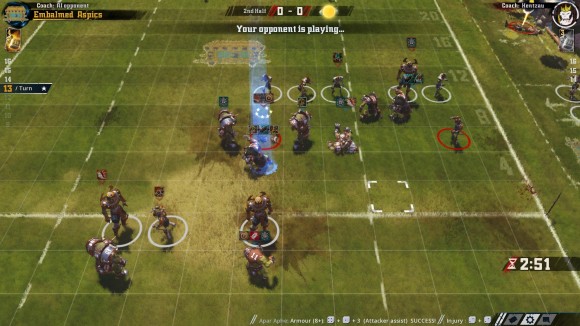
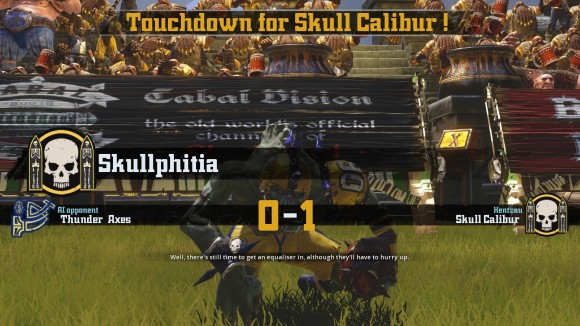

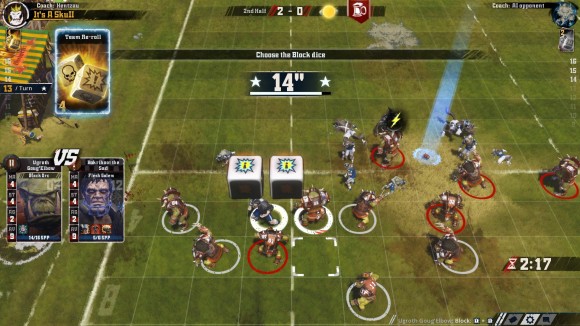
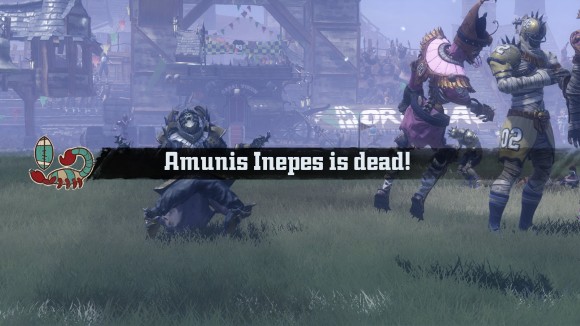
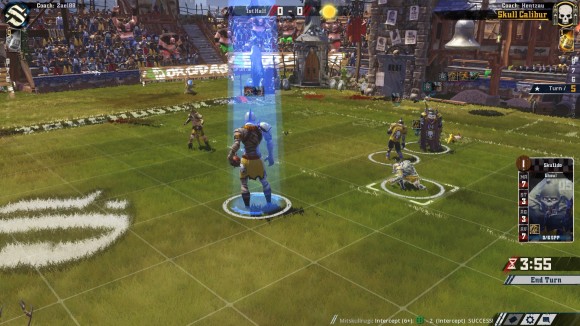
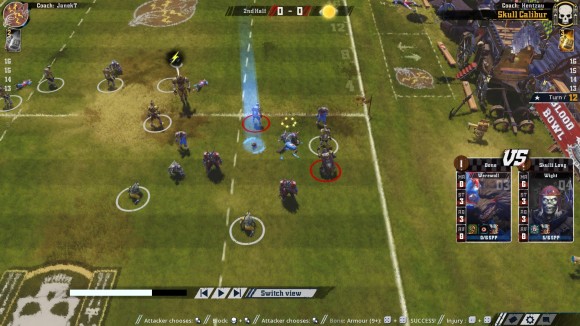
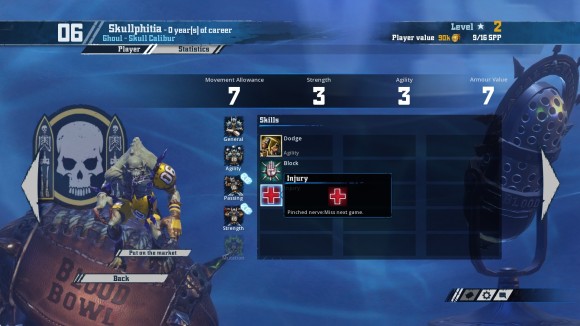
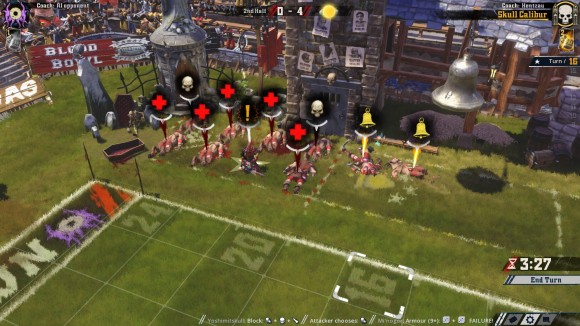
hello
I stumbled across your blog when searching for Space Hulk probability numbers on Google. I think the blog is really great and you cover very interesting games, many of which meet my own tastes.
I just wanted to recommend two great games: Talisman Digital Edition and Darkest Dungeon as great games which i love which you do not seem to have covered, but i suspect would be right up your alley.
Thanks
The problem with BB is that the rules were designed for a game which was played every so often on a board with a few mates. An experienced team might have played say 20 games. Now when you are facing teams with 100s of games, a bash play style is so utterly dominant to make anything other than chaos or maybe necromantic teams (undead with werewolves) sub optimal. Against opponents who can pack the line of scrimmage with claw-mighty blow-piling on players you expect to lose 1-2 players on the first turn every time you defend. Being pitch cleared is normal, and elf teams with five rostered players are common. Until that’s fixed in the rules, league blood bowl is spirit crushing.
Hi there, just want to nit pick something you stated when discussing the effect that skills have on dice rolls, specifically re-rolls. You say “he’d be able to automatically reroll a single failed pickup roll per turn, meaning he’d have to roll a 1 or 2 on two dice at the same time to fail the roll outright and which reduces the chance of failure to one in nine” This is actually incorrect. There is a statistical difference between making 2 sequential rolls (i.e. a failed roll and a re-roll) and rolling 2 dice simultaneously where you only need one die to have the desired result. As an example, lets say you absolutely need to knockdown an opposing player, but you can only get a one die block, so you need a Defender Down or Defender Stumbles, which is 1 in 3. You fail the roll because Nuffle hates you at the moment, so you spend your re-roll, and, since probability is discreet and acts brand new for every single die roll, you now have a 1 in 3 chance again. However, let’s say you can bring over a support player to make it a 2-die Block. In this case, you only care that one die of the two has the desired result, ignoring the result of the second die, giving you 20 succeeds out of a possible 36 outcomes, for a 55.6% success rate. I hope this makes sense, and don’t feel bad, it’s totally counter-intuitive…
To Aaron, the reason what you said is “totally counter-intuitive” is because it’s not true!
For some reason, you changed the author’s scenario from failure 1/3 of the time to success 1/3 of the time. I’ll stick with the author’s failure 1/3 of the time scenario. The probability of success with a reroll is 4/6 + (1/6)*(4/6) + (1/6)*(4/6)=32/36, so the chance of failure is 1-SuccessChance=1-(32/36)=4/36=1/9, which is exactly what the author said. The way that probability logic reads is this: four sixths of the time the author will succeed on the first die roll, and so initial failure occurs with a roll of either 1 or 2; when the author rolls only a 2, which happens one-sixth of the time, a reroll will still yeild success four sixths of that time, and when the author rolls only a 1, which happens the final one-sixth of the time ["final", because 4/6+1/6+1/6=6/6], a reroll will still yield success four sixths of that time. Reworded, four sixths of the time that an initially failing 1 or 2 is rolled, success will still result after the second roll. It’s like a weighted average; success happens 100% of the time on a 4–6 roll, but still also happens 66.6% of the time on an initial 2 roll, and 66.6.% of the time on an initial 1 roll. Even easier is the other scenario you brought up where both dice are rolled together and either die can be a 3–6 to result in success. In such a scenario, the only failure results will be a roll with both dice are 1, both dice are 2, die 1 is 1 & die 2 is 2, or die 1 is 2 & die 2 is 1; the other 32 cominations will all be successes. Guess what? That’s also a 32/36 success rate, and therefore a failure rate of 4/36=1/9. So it makes no difference how you think about it, sequential or simultaneously.
For the record, your 55.6% success rate is the correct probability for your alternative scenario of throwing 2 dice simultaneously (20 succeeds out of 36 possible outcomes=55.6% success) where you only succeed with a roll of a 5 or 6. It just doesn’t do anything to prove the distinction you’re claiming between sequential and simultaneous since for your other scenario, sequentially throwing the dice, probability is 1/3 + (2/3)*1/3=0.556, for which the probability logic reads as this: one third of the time you’ll succeed right off the bat, but even for the other two thirds of the time that you get inital failure, you’ll still succeed one-third of that time. So even here it doesn’t matter whether you roll the dice sequentially or simultaneously. You gave the reason yourself, “probability is discreet and acts brand new for every single die roll.” So each die has no knowledge, nor is it affected by, what the other die does. That is to say that the dice don’t KNOW whether they’re being rolled sequentially or simultaneously, and a roll of a single 5 or single 6 on either of the two six-sided dice will net you a successful result.
I liked Chaos League quite a bit and have not had a chance to try Blood Bowl. I would be interested in something more realtime… perhaps something like DOTA meets Blood Bowl… any suggestions?